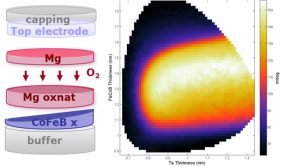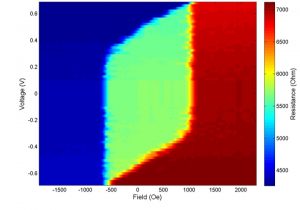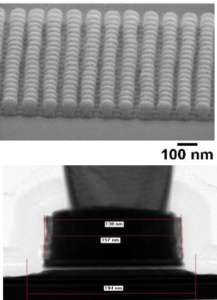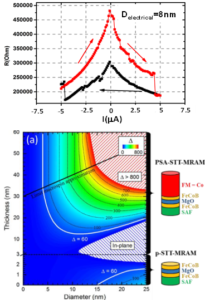Overview
The Magnetic Random Access Memories (MRAM) group develops advanced concepts in this emerging technology. The goal is to realize cells with improved thermal stability, lower power consumption and/or faster switching. Our research covers material stack deposition, nano-fabrication and electrical test evaluation, for applications as standalone memory and non-volatile logic and more recently in neuromorphic computing architectures.
Research directions
Perpendicular Anisotropy Materials

High energy barriers for spin transfer torque (STT) MRAM cells can be achieved with perpendicular anisotropy magnetic tunnel junctions. Solutions for high density MRAM cells to diameters below 20nm require continuous improvements in perpendicular surface anisotropy, while maintaining high TMR properties.
Perpendicular STT MRAM

Evaluation of MRAM concepts requires simulation of expected reversal mechanisms and electrical characterization of individual cells. We aim at understanding dynamics of magnetization reversal and the expected impact of stack modifications to explore application specific optimizations.
Nanofabrication Challenges

Innovation on dense MRAM using pre-patterned substrates, CMOS integration of multifunctional cells and sub-10nm lateral sizes. Tunnel junction nanofabrication in our platform is essential to evaluate MRAM concepts and performance.
Perpendicular Shape Anisotropy

A solution for sub-10nm cell sizes uses high aspect ratios to generate perpendicular shape anisotropy providing scalable retention at the smallest cell sizes. Spin transfer torque switching is possible in these cells, where the reversal dynamics is now under study.
The team
Former members
Post-docs
- Andrey TIMOPHEEV (2014-2017)
- Van Dai NGUYEN (2016-2018)
- J. Ranier Roiz (2015-2016)
- Nikita Strelkov (2016-2019)
PhD
- Luc TILLIE (2015-2018)
- Nicolas PERRISSIN (2015-2018)
- Jyotirmoy CHATTERGEE (2014-2017)
- Hieu Tan NGUYEN (2013-2016)
- Antoine Chavent (2013-2015)
Process Engineers
- Jude GUELFFUCCI (2015-2017)
- Nathalie LAMARD (2016-2017)
- Guillaume LAVAITTE (2015-2016)
Projects
- Samsung SGMI (2014-2017)
- ANR Excalyb (2014-2017)
- Heumem (2015-2018)
- EU-FET Spice (2016-2019)
- EU Great (2016-2019)
- ERC Magical (2015-2020)
Partners
- CEA LETI, Grenoble, France
- Institut NEEL, Grenoble, France
- Crocus Technology, Grenoble, France
- Samsung, San Jose, USA
- Singulus AG, Kahl am Main, Germany
- Aarhus University, Aarhus, Denmark
- Radboud Universiteit, Neijmegen, Netherlands
Recent news
- PhD Defense – Microscopie électronique operando pour l’étude de mémoires magnétiques (November 14th, 2025)

Jeudi 4 décembre à 14h Augustin Nogier (SPINTEC) soutiendra sa thèse intitulée : Microscopie électronique operando pour l’étude de mémoires magnétiques Lieu : Minatec Chrome I. La soutenance sera suivie d’une réception à la maison Minatec ... - Physics of current-induced switching in 3D nanopillars (November 03rd, 2025)

We simulated the current-induced switching of magnetization of short vertical magnetic nanopillars as the free layer in a magnetic tunnel junction. Considering spin accumulation is crucial in such 3D elements, leading to an enhancement of ... - Controlling effective anisotropy for efficient switching at cryogenic temperature (October 24th, 2025)

The field of cryoelectronics holds promise for high-performance computing applications, particularly within the realm of quantum computing. Recent advances in quantum computing systems have spurred the investigation of various technologies suitable for cryogenic environments. Among ... - PhD Defense – Development of SOT-MRAM technology for integration in functional devices (September 29th, 2025)

On Friday October 10th, at 14:00, Kuldeep RAY (SPINTEC) will defend his PhD thesis entitled : Development of SOT-MRAM technology for integration in functional devices Place : IRIG/SPINTEC, CEA Building 10.05, auditorium 445 (presential access to ... - Magnetic vortex dynamics probed by time-resolved magnetic helicoidal dichroism (September 12th, 2025)

Time-resolved magnetic helicoidal dichroism (MHD) was successfully used to assess the ultra-fast dynamics of magnetization. This first attempt to use an MHD-based technique was demonstrated on a magnetic vortex structure hosted by a permalloy pacman ...















